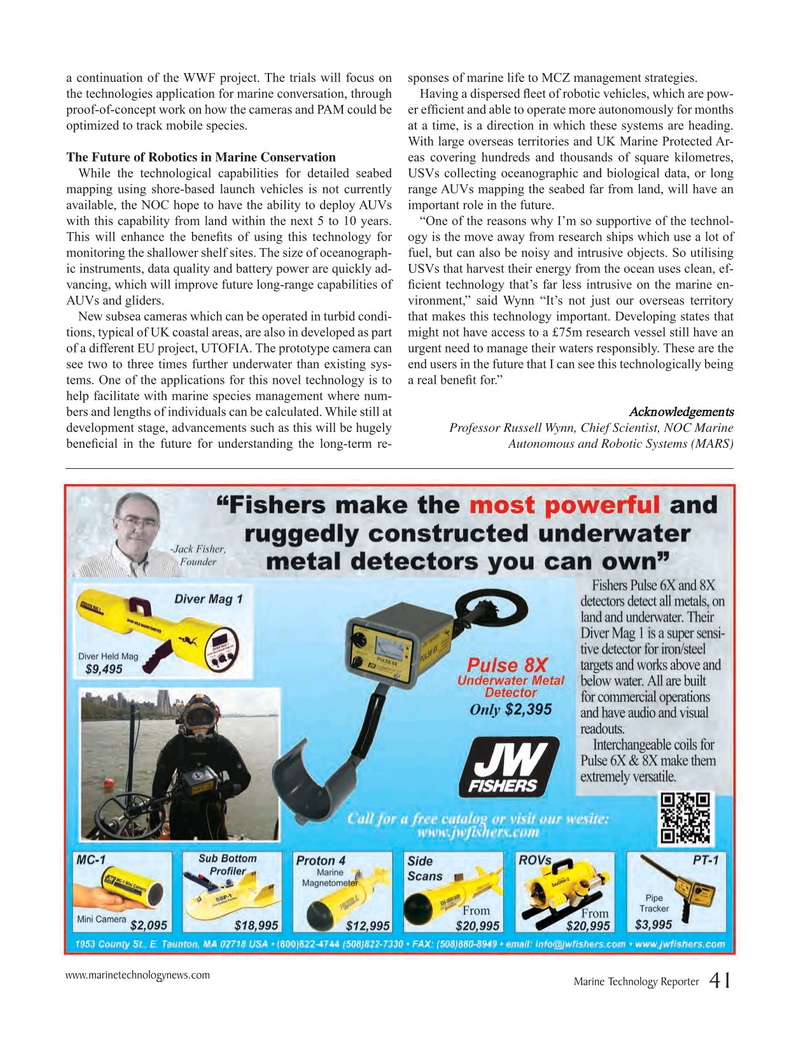
Page 41: of Marine Technology Magazine (March 2016)
Oceanographic Instrumentation: Measurement, Process & Analysis
Read this page in Pdf, Flash or Html5 edition of March 2016 Marine Technology Magazine
a continuation of the WWF project. The trials will focus on sponses of marine life to MCZ management strategies.
the technologies application for marine conversation, through Having a dispersed ? eet of robotic vehicles, which are pow- proof-of-concept work on how the cameras and PAM could be er ef? cient and able to operate more autonomously for months optimized to track mobile species. at a time, is a direction in which these systems are heading.
With large overseas territories and UK Marine Protected Ar-
The Future of Robotics in Marine Conservation eas covering hundreds and thousands of square kilometres,
While the technological capabilities for detailed seabed USVs collecting oceanographic and biological data, or long mapping using shore-based launch vehicles is not currently range AUVs mapping the seabed far from land, will have an available, the NOC hope to have the ability to deploy AUVs important role in the future. with this capability from land within the next 5 to 10 years. “One of the reasons why I’m so supportive of the technol-
This will enhance the bene? ts of using this technology for ogy is the move away from research ships which use a lot of monitoring the shallower shelf sites. The size of oceanograph- fuel, but can also be noisy and intrusive objects. So utilising ic instruments, data quality and battery power are quickly ad- USVs that harvest their energy from the ocean uses clean, ef- vancing, which will improve future long-range capabilities of ? cient technology that’s far less intrusive on the marine en-
AUVs and gliders. vironment,” said Wynn “It’s not just our overseas territory
New subsea cameras which can be operated in turbid condi- that makes this technology important. Developing states that tions, typical of UK coastal areas, are also in developed as part might not have access to a £75m research vessel still have an of a different EU project, UTOFIA. The prototype camera can urgent need to manage their waters responsibly. These are the see two to three times further underwater than existing sys- end users in the future that I can see this technologically being tems. One of the applications for this novel technology is to a real bene? t for.” help facilitate with marine species management where num- bers and lengths of individuals can be calculated. While still at Acknowledgements development stage, advancements such as this will be hugely Professor Russell Wynn, Chief Scientist, NOC Marine bene? cial in the future for understanding the long-term re- Autonomous and Robotic Systems (MARS) www.marinetechnologynews.com
Marine Technology Reporter 41
MTR #2 (34-49).indd 41 2/19/2016 11:50:33 AM

 40
40

 42
42
